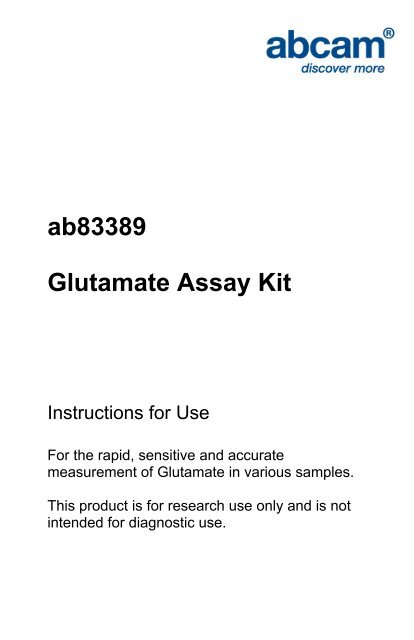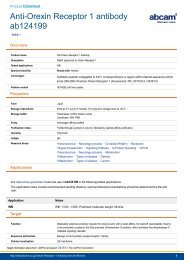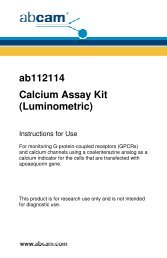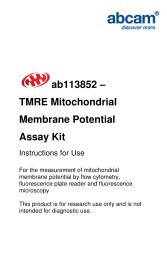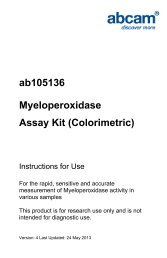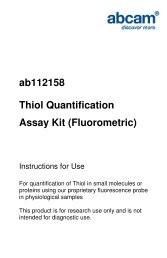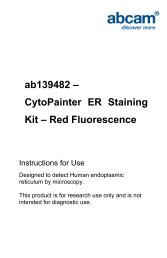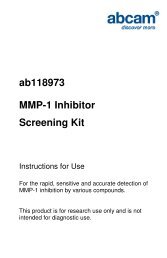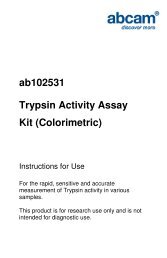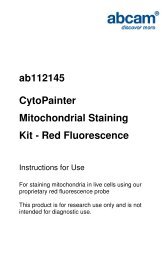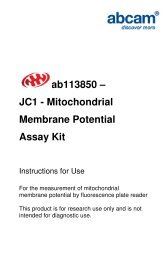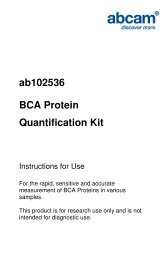ab83389 Glutamate Assay Kit - Abcam
ab83389 Glutamate Assay Kit - Abcam
ab83389 Glutamate Assay Kit - Abcam
Create successful ePaper yourself
Turn your PDF publications into a flip-book with our unique Google optimized e-Paper software.
B. Additional Materials RequiredMicrocentrifugePipettes and pipette tipsColorimetric microplate reader96 well plateOrbital shaker6
4. <strong>Assay</strong> Protocol1. Sample Preparation:a. For tissues or cell samples: Tissues or cells (1×10 6 ) canbe homogenized in 100 μl <strong>Assay</strong> Buffer. Centrifuge toremove insoluble material at 13,000 x g for 10 minutes.b. For serum samples: 10-50 μl serum samples can bedirectly diluted in the <strong>Assay</strong> Buffer.Bring sample wells to 50 μl/well with <strong>Assay</strong> Buffer in a 96-well plate.Prepare a parallel sample well as the background control.We suggest testing several doses of your sample to make sure thereadings are within the standard curve range.2. Standard Curve Preparation:Dilute 10 μl of the 0.1M <strong>Glutamate</strong> standard with 990 μl <strong>Assay</strong> Bufferto generate 1 mM standard <strong>Glutamate</strong>. Add 0, 2, 4, 6, 8, 10 μl of thediluted <strong>Glutamate</strong> standard into a 96-well plate in duplicate togenerate 0, 2, 4, 6, 8, 10 nmol/well standard. Bring the volume to50 μl with <strong>Assay</strong> buffer.3. <strong>Glutamate</strong> Reaction Mix:a) Reconstitute <strong>Glutamate</strong> Enzyme Mix with 220 μl <strong>Assay</strong> Buffer.Aliquot enough <strong>Glutamate</strong> Enzyme Mix (2 μl per assay) for thenumber of assays to be performed in each experiment and freezethe stock solution immediately at -20°C for future use.7
The <strong>Glutamate</strong> Enzyme Mix is stable for up to 2 months at -20°Cafter reconstitution or freeze-thaw cycle less than 5 times.b) Reconstitute <strong>Glutamate</strong> Developer with 820 μl of ddH 2 O. Pipetteup and down several times to completely dissolve the pellet intosolution (Don’t vortex).c) Mix enough reagents for the number of samples and standards tobe performed. For each well, prepare a total 100 μl Reaction Mix:Reaction Mix Bkgd Control Mix<strong>Assay</strong> Buffer 90 µl 92 µl<strong>Glutamate</strong> Developer 8 µl 8 µl<strong>Glutamate</strong> Enzyme Mix 2 µl --Add 100 μl of the Reaction Mix to each well containing the<strong>Glutamate</strong> Standard and test samples. To the background controlwell, add 100 µl of background control mix. Mix well. Incubate at37°C for 30 minutes, protect from light.4. Measure OD at 450 nm in a microplate reader.8
5. Data AnalysisCorrect background by subtracting the value derived from thebackground control from all sample readings (The backgroundreading can be significant and must be subtracted from samplereadings). Plot <strong>Glutamate</strong> standard curve. <strong>Glutamate</strong> concentrationsof the test samples can then be calculated:Concentration = Sa / Sv nmol/μl, or mMWhere:Sa is the sample amount of unknown (in nmol) from standard curve,Sv is sample volume (μl) added into the wells.L-Glutamic acid Molecular Weight is 147.13 g/mol.9
6. TroubleshootingProblem Reason Solution<strong>Assay</strong> notworkingUnexpectedresults<strong>Assay</strong> buffer atwrong temperatureProtocol step missedPlate read atincorrect wavelengthUnsuitable microtiterplate for assayMeasured at wrongwavelengthSamples containimpeding substancesUnsuitable sampletypeSample readings areoutside linear range<strong>Assay</strong> buffer must not be chilled- needs to be at RTRe-read and follow the protocolexactlyEnsure you are usingappropriate reader and filtersettings (refer to datasheet)Fluorescence: Black plates(clear bottoms);Luminescence: White plates;Colorimetry: Clear plates.If critical, datasheet will indicatewhether to use flat- or U-shapedwellsUse appropriate reader and filtersettings described in datasheetTroubleshoot and also considerdeproteinizing samplesUse recommended samplestypes as listed on the datasheetConcentrate/ dilute samples tobe in linear range10
SampleswithinconsistentreadingsLower/Higherreadings insamplesandstandardsUnsuitable sampletypeSamples prepared inthe wrong bufferSamples notdeproteinized (ifindicated ondatasheet)Cell/ tissue samplesnot sufficientlyhomogenizedToo many freezethawcyclesSamples containimpeding substancesSamples are too oldor incorrectly storedNot fully thawed kitcomponentsOut-of-date kit orincorrectly storedreagentsReagents sitting forextended periods oniceIncorrect incubationtime/ temperatureIncorrect amountsusedProblem Reason SolutionRefer to datasheet for detailsabout incompatible samplesUse the assay buffer provided(or refer to datasheet forinstructions)Use the 10kDa spin column(ab93349)Increase sonication time/number of strokes with theDounce homogenizerAliquot samples to reduce thenumber of freeze-thaw cyclesTroubleshoot and also considerdeproteinizing samplesUse freshly made samples andstore at recommendedtemperature until useWait for components to thawcompletely and gently mix prioruseAlways check expiry date andstore kit components asrecommended on the datasheetTry to prepare a fresh reactionmix prior to each useRefer to datasheet forrecommended incubation timeand/ or temperatureCheck pipette is calibratedcorrectly (always use smallestvolume pipette that can pipetteentire volume)11
Standardcurve is notlinearNot fully thawed kitcomponentsPipetting errors whensetting up thestandard curveIncorrect pipettingwhen preparing thereaction mixAir bubbles in wellsConcentration ofstandard stockincorrectErrors in standardcurve calculationsUse of otherreagents than thoseprovided with the kitWait for components to thawcompletely and gently mix prioruseTry not to pipette too smallvolumesAlways prepare a master mixAir bubbles will interfere withreadings; try to avoid producingair bubbles and always removebubbles prior to reading platesRecheck datasheet forrecommended concentrations ofstandard stocksRefer to datasheet and re-checkthe calculationsUse fresh components from thesame kitFor further technical questions please do not hesitate tocontact us by email (technical@abcam.com) or phone (select“contact us” on www.abcam.com for the phone number foryour region).12
UK, EU and ROWEmail: technical@abcam.comTel: +44 (0)1223 696000www.abcam.comUS, Canada and Latin AmericaEmail: us.technical@abcam.comTel: 888-77-ABCAM (22226)www.abcam.comChina and Asia PacificEmail: hk.technical@abcam.comTel: 108008523689 ( 中 國 聯 通 )www.abcam.cnJapanEmail: technical@abcam.co.jpTel: +81-(0)3-6231-0940www.abcam.co.jp15Copyright © 2012 <strong>Abcam</strong>, All Rights Reserved. The <strong>Abcam</strong> logo is a registered trademark.All information / detail is correct at time of going to print.


